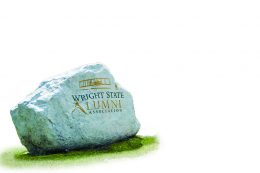
Internationally recognized sculptor David Black’s Turning Points was installed in the University Hall plaza in 1999. Affectionately called “BART” by many Raiders, this piece of architectural artwork is now one of the most recognizable symbols on Wright State’s Dayton Campus.
The Western Ohio Educational Foundation (WOEF) organized the first courses for what would eventually become the Wright State University–Lake Campus in 1962. Classes were initially held in a local high school, but as interest in the college continued to build, the WOEF Board was challenged to provide additional space and faculty for a growing number of students.
Through a series of successful fund drives, the WOEF Board assured the growth of the college through the purchase of a vacant public school building in Celina, Ohio. In 1969, the WOEF Board voted for the college to become fully affiliated with Wright State University, and the campus soon moved to a 173-acre site on the northern shores of Grand Lake St. Marys. Known as the Western Ohio Branch Campus then, it was renamed the Wright State University–Lake Campus in the latter half of the 1980s.
 Today, more than 1,300 students call the Lake Campus home. Lake Campus continues to add programs and majors that serve the needs of western Ohio communities. It currently offers 13 associate degrees and 11 bachelor’s degrees in such diverse fields as graphic design, law enforcement, and food systems management.
Today, more than 1,300 students call the Lake Campus home. Lake Campus continues to add programs and majors that serve the needs of western Ohio communities. It currently offers 13 associate degrees and 11 bachelor’s degrees in such diverse fields as graphic design, law enforcement, and food systems management.
The Lake Campus recently added townhouse-style apartments for students who would like to live on campus, and a new center is scheduled for completion in early 2018 to house the campus’s fast-growing agricultural program and research on water quality from the surrounding watershed.
Alumni Tower
Many faculty, staff, and alumni have fond memories of the tower that stood at the entrance to campus for many years. In 2002, the tower was renamed Alumni Tower and relocated to the lawn behind the Student Union near the then-future site of the Neuroscience Engineering Collaboration Building. It serves as a physical tribute to all Wright State graduates and as a symbol of the university itself.
 The lawn surrounding AlumniTower hosts many events, including a welcome lunch for new students to meet the university president before fall classes begin and an annual graduation picnic in the spring hosted by the Alumni Association. In 2013, the area was transformed into an inviting gathering space called Alumni Grove.
The lawn surrounding AlumniTower hosts many events, including a welcome lunch for new students to meet the university president before fall classes begin and an annual graduation picnic in the spring hosted by the Alumni Association. In 2013, the area was transformed into an inviting gathering space called Alumni Grove.
“It was just wide-open grass,” said alumnus and Alumni Association board member Tony Alexander (’88), who helped establish Alumni Grove. “My thought was, let’s do something to beautify the area and make it more attractive. Make it a place where students, staff, faculty, and alums can come and enjoy the area.”
Alumni can leave a legacy by funding a personalized brick paver, a planted tree, or a wooden bench. These generous gifts also support the Alumni Association’s Legacy Scholarship. To date, more than $30,000 in scholarship funds have been raised through the Alumni Grove project.
The NEC Building
 The Neuroscience Engineering Collaboration Building opened in April 2015, bringing researchers from six disciplines under one roof, working with area health professionals to understand brain, spinal cord, and nerve disorders.
The Neuroscience Engineering Collaboration Building opened in April 2015, bringing researchers from six disciplines under one roof, working with area health professionals to understand brain, spinal cord, and nerve disorders.
It houses basic researchers working to understand biological processes, clinical researchers who use that knowledge to develop treatments and cures, and engineers who create medical devices and imaging technologies.
The Rock
 The Rock, originally located by Wright State University’s main entrance on Colonel Glenn Highway, was relocated to Springwood Lane and University Boulevard in September 1998, in accordance with Wright State’s Master Plan. Reactions from students were mixed, especially when the company contracted to move the Rock placed it on the wrong side of the road. In its time, the much-painted Rock has been the canvas for student organization announcements, political protests—and even a marriage proposal.
The Rock, originally located by Wright State University’s main entrance on Colonel Glenn Highway, was relocated to Springwood Lane and University Boulevard in September 1998, in accordance with Wright State’s Master Plan. Reactions from students were mixed, especially when the company contracted to move the Rock placed it on the wrong side of the road. In its time, the much-painted Rock has been the canvas for student organization announcements, political protests—and even a marriage proposal.

 Museum-quality replica of historic Hawthorn Hill donated to Wright State
Museum-quality replica of historic Hawthorn Hill donated to Wright State  Wright State celebrates more than 1,000 graduates at fall 2025 commencement
Wright State celebrates more than 1,000 graduates at fall 2025 commencement  2026 Alumni Achievement Awards celebrate distinguished Wright State community members
2026 Alumni Achievement Awards celebrate distinguished Wright State community members  Bags, boards and bonding
Bags, boards and bonding  More than 1,000 students to graduate at Wright State’s fall commencement ceremonies
More than 1,000 students to graduate at Wright State’s fall commencement ceremonies 